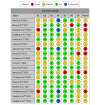Emergency Department Programs to Support Medication Safety in Older Adults: A Systematic Review and Meta-Analysis
- PMID: 40067297
- PMCID: PMC11897843
- DOI: 10.1001/jamanetworkopen.2025.0814
Emergency Department Programs to Support Medication Safety in Older Adults: A Systematic Review and Meta-Analysis
Abstract
Importance: Given that older adults are at high risk for adverse drug events (ADEs), many geriatric medication programs have aimed to optimize safe ordering, prescribing, and deprescribing practices.
Objective: To identify emergency department (ED)-based geriatric medication programs that are associated with reductions in potentially inappropriate medications (PIMs) and ADEs.
Data sources: A systematic search of Scopus, Embase, PubMed, PsycInfo, ProQuest Central, CINAHL, AgeLine, and Cochrane Library was conducted on February 14, 2024, with no date limits applied.
Study selection: Randomized clinical trials or observational studies focused on ED-based geriatric (aged ≥65 years) medication programs that provide ED clinician support to avoid PIMs and reduce ADEs.
Data extraction and synthesis: Preferred Reporting Items for Systematic Reviews and Meta-Analyses guidelines for abstracting data and the Cochrane risk-of-bias tool were used to assess data quality and validity. Abstract screening and full-text review were independently conducted by 2 reviewers, with a third reviewer acting as an adjudicator.
Main outcomes and measures: Process (ordering, prescribing, and deprescribing PIM rates) and clinical (ADE, health care utilization, and falls) outcomes.
Results: The search strategy identified 3665 unique studies, 98 were assessed for eligibility in full-text review, and 25 studies, with 44 640 participants, were included: 9 clinical pharmacist reviews (with 28 360 participants), 1 geriatrician teleconsultation (with 50 participants), 8 clinician educational interventions (with 5888 participants), 4 computerized clinical decision support systems (CDSS; with 9462 participants), and 3 fall risk-increasing drug (FRID) reviews (with 880 participants). Clinical pharmacist review was not associated with decreased hospital admission or length of stay, but 2 studies showed a 32% reduction in PIMs from deprescribing (odds ratio [OR], 0.68 [95% CI, 0.50-0.92]; P = .01). One study also found that ED geriatrician teleconsultation was associated with enhanced deprescribing of PIMs. Three clinician educational intervention studies showed a 19% reduction in PIM prescribing (OR, 0.81 [95% CI, 0.68-0.96]; P = .02). Two computerized CDSS studies showed a 40% reduction in PIM ordering (OR, 0.60 [95% CI, 0.48-0.74]; P < .001). FRID reviews were not associated with reduced time to first fall or fall recurrence at 12 months.
Conclusions and relevance: In this systematic review and meta-analysis of ED-based geriatric medication safety programs, a multidisciplinary team, including clinical pharmacists and/or geriatricians, was associated with improved PIM deprescribing. Furthermore, computerized CDSS, alone or in combination with ED clinician education, was associated with enhanced geriatric ordering and prescribing practices. These findings will inform the Geriatric ED Guidelines version 2.0 update.
Conflict of interest statement
Figures




References
-
- Cairns C, Kang K. National Hospital Ambulatory Medical Care Survey: 2020 emergency department summary tables. National Center for Health Statistics. Accessed February 5, 2025. https://www.cdc.gov/nchs/data/nhamcs/web_tables/2020-nhamcs-ed-web-table...
Publication types
MeSH terms
Grants and funding
LinkOut - more resources
Full Text Sources
Medical

